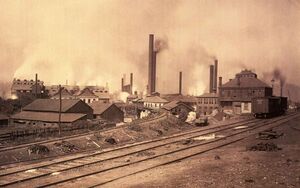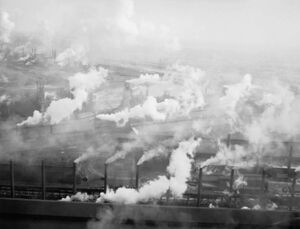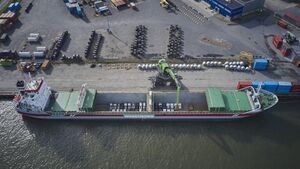Arcerion Steel Corporation: Difference between revisions
| Line 58: | Line 58: | ||
Arco Steel remains one of the largest employers in Arcerion as well as having one of the largest market shares of the national GDP. It has remained resilient in the face of consistent recessions and economic depressions across Ixnay, as well as an Arcer economy that has largely begun to shift to a post-industrial economy. It remains a key part of both Arcer heritage as well as acting as the cornerstone of Easthampton. It is largely responsible for the success of Moorden Governorate in the late 1800s and early 1900s before the large Arcer agricultural revolution at the turn of the 20th century, and remains a major player in Crona for steel and mineral production, as well as across Ixnay. | Arco Steel remains one of the largest employers in Arcerion as well as having one of the largest market shares of the national GDP. It has remained resilient in the face of consistent recessions and economic depressions across Ixnay, as well as an Arcer economy that has largely begun to shift to a post-industrial economy. It remains a key part of both Arcer heritage as well as acting as the cornerstone of Easthampton. It is largely responsible for the success of Moorden Governorate in the late 1800s and early 1900s before the large Arcer agricultural revolution at the turn of the 20th century, and remains a major player in Crona for steel and mineral production, as well as across Ixnay. | ||
Arco steel also remains as one of the largest Megacorporations in Crona, having larger revenue and market share than the GDP of [[Kelekona]], [[Malentina]], and [[Porlos]], all Indigenous neighbours of Arcerion. It maintains significant political influence in Arcerion, and across Crona. With the increase of lobbying in Stenza and abroad, it sees its influence increasing as part of Arcer economic engagements abroad. | |||
== Facilities == | == Facilities == | ||
easthampton mines | easthampton mines | ||
| Line 78: | Line 75: | ||
== Major Markets == | == Major Markets == | ||
placeholder | placeholder | ||
* {{flagicon|Stenza}} | * {{flagicon|Stenza}} Republic of Stenza; | ||
* {{flagicon|Alstin}} | * {{flagicon|Alstin}} United Republic of Alstin; | ||
* {{flagicon|Corumm}} | * {{flagicon|Corumm}} Democratic Republic of Corumm; | ||
* Levantia | * Levantia; | ||
* Sarpedon | * Sarpedon; | ||
[[Category:Arcerion]] | [[Category:Arcerion]] | ||
Revision as of 14:25, 15 December 2022
Arcerion Steel Corporation, more commonly known in Ixnay as Arco Steel, is an Arcer steel producer and iron ore mining corporation headquartered in Kurst, Arcerion with production and extraction facilities primarily in the Aileach Mountains and with subsidiary corporations in Southern Crona. It is consistently ranked as one of the largest steel producers in Ixnay, and is the largest in Crona, and by 2030 is estimated to be the main steel exporter to Sarpedon.
It has gone through several different iterations and reformations since its inception in 1848, and maintains a close working relationship with energy sector partners due to the oil field exploitation in the Albion Sea.
History
Roughly a decade after the founding of Easthampton, Arcerion Steel Corporation was registered with the Lieutenant-Governor's office as a Crown Corporation, although shortly thereafter it was bought back by private investors, notably John O. Marsden, Reginald Billsworth, and Adam F. Chauncey. With the initial founding of the company, mining operations were set up for iron ore strip mining, with ground broken in 1849, a year after the company was registered. The strip mine began by using a light rail network to transport the ore to Chester-on-Moore but under the supervision of the first steel magnate, John O. Marsden, there was an opportunity to secure funding from the Arcer government and the Ardmori Crown, and establish the company's first steel plant.
First Factories (1848-1902)
The first steel factory, employed a few hundred naturalized Arcers, Ardmori immigrants, and indigenous labourers began its operations in refinement of raw iron ore into finished, flat rolled steel, the first finished pieces being shipped via the Arcer National Railway Service (ARNS) to Chester-on-Moore in 1851. Marsden ensured that wharf and dockyard facilities were bought, and worked on building and establishing a relationship with merchant mariners from Burgundie to ship the steel abroad, seeing as the Arcer shipbuilding industry had yet to create any large commercial freighters, instead focusing on inland expansion and railways, as the Ardmori government and Crown was contributing the majority of the ships and naval commerce to their Cronan colony.
Marsden, then Chairman of the Board of Directors, assigned Billsworth to travel to Chester-on-Moore, then well on track becoming the largest commercial sea port in Arcerion, to establish a subsidiary of Arco Steel, to store and ship the final finished products to their growing customer base in Levantia. The cheaper and high quality Arcer steel was increasingly becoming a more attractive option than domestically produced steel, as the imports could leverage Arcerion's relatively small and growing economy versus the tighter margins of contemporary Levantine counterparts. This was concurrent in Sarpedon, where Arco Steel was becoming a consistent choice for the use of constructing new industrial facilities due to its low buying cost. An 1859 agreement between the ARNS and Arco Steel established the Chester Steel Station, a major railhead and loading/offloading facility for Arcer steel in Chester-on-Moore, and created a satellite facility in Port Hughes to the Southwest to accommodate for a growing surplus of steel produced.
Thanks in part to a large number of foreign buyers, Arco Steel was becoming one of the major industrial competitors in Crona, allowing the opening of a second factory by by 1970. Increases in orders from Crona, Levantia, and Sarpedon meant that a subsidiary company was set up in conjunction with major ship builders in Foxhey Governorate, Arcerion Steel Shipping Lines, which allowed for a more seamless integration of the steel exports, staffed by a number of former members of the Royal Arcerion Naval Service. This coincided with a secondary factory, constructed adjacent to the first in Easthampton, and doubled the amount of employees to several thousand across its many divisions now.

As of 1880, the company now separated into three divisions, Iron Ore Extraction, Manufacturing, and Shipping/Exports. Marsden overall maintained on the board as Chairman but had consolidated power and pushed out Billsworth and Chauncey, replacing them with 'company men' who had worked their way up the corporate ladder since Arco Steel's founding three decades before. Steel exports to Levantia had continued to grow, and with the industry now becoming the single most important company in Easthampton, Arco Steel was poised to be the largest corporation in Arcerion by 1900, but with the arrival of the First Great War, there was a distinct shift. Battles as part of the Arco-Paul conflict spilled out of Washakara and into Easthampton, damaging the plant's ability to produce steel. The Arcerion Parachute Regiment, at that time the Duke of Lincolnshire's Regiment, was awarded a regimental battle honour for defending Easthampton, and set their Regimental Headquarters within Factory No.1's own offices, and their mortars and artillery in the plant itself. This spawned an affiliation between the two organizations, and with the war's conclusion and Arco Steel continuing production and operations, Marsden annually paid for a Christmas Dinner to be put on for the Regiment, a tradition that continues in modern times.
Interwar & Second Great War Period (1906-1943)
The Interwar period saw a significant expansion of Factory No.2, tripling in size as it tried to keep up with the demand for Arcer steel from major export markets in Crona and Levantia. The expansion continued with more extensive supply chain investments in Chester-on-Moore, as well as the size and capabilities of the Arcer railways ability to ship steel to the coast from the Aileach Mountains. The company had only operated off of a single set of double-track rail lines to Kurst and and Chester-on-Moore, and bought a majority stake in the Railway, doubling the amount of track laid during the late 1880s, to allow for more steel to be sent to Arcerion's main Southern commercial port in Chester-on-Moore. The death of Marsden in 1919 (at the age of 93) saw a new period evolve for the company. Marsden's three sons, John Jr., James, and Nathaniel all retained board seats and established a commanding and sizeable control of the company, solidifying the Marsden family's role in Arco Steel and as a dynastic family, one of the few in Arcerion that grew from naturalized citizens and native Arcers rather than existing old-world Occidental noble families.

With the Second Great War rapidly approaching with a breakdown of relations between Urcea and Caphiria, Factory No.3 was opened and prepared for operations with the arrival of hostilities. Arco Steel only narrowly missed being nationalized back into a Crown Corporation, but after a lengthy litigation, mediation, and legal battle with the Confederate Parliament and the Supreme Court of Arcerion, Arco Steel remained a public corporation. The agreement meant that Arco Steel would produce much of the raw metal and materials for the creation of manufacturing plants and other major facilities to produce tanks, armoured vehicles, and heavy weaponry for the Arcer war effort.
By the war's conclusion, Arcer steel was found in tanks, planes, and ships across the Allies side, and the relationship forged with Burgundie and Alstin meant that much of Arcerion's steel successfully managed to make it to the customers and importers in Levantia and Sarpedon, as convoys escorted the commercial vessels beyond the Songun Sea. The company's profits dipped during this period as it worked on credit, the Arcer government generating a sizeable debt to Arco Steel due to the massive requirements of the war effort and already strained public relations due to the volume of war bonds that had been bought. With over 20,000 employees in both factories, rail yards, warehouses, and mines, the company was already one of the largest in Arcerion and set to become one of the largest in Crona.
Post-War and Modern Era (1944-present)
After the war's conclusion, the repayments with interest by the Arcer government, as well as with a massive surge in buying due to the need for reconstruction meant that Arco Steel saw a rise in its stock price and international orders. The surge of orders continued to be unmatched going into the 1960s and 1970s, with employees across Arcerion numbering over 100,000 and giving Easthampton, despite its small and relatively unimportant geographical location, a disproportionate political role in Arcer politics. Moorden's economy became heavily dependent on both Kinnaird's financial mechanisms, as well as Easthampton's steel export and production. The majority stake in the Railway Service meant that there was an increase to a quadruple track line on the Easthampton-Kurst-Chester-on-Moore line, bringing raw iron ore and finished steel to the ports for shipping abroad.

The massive steel boom in the 1960s and 1970s coincided with the establishment of four new factories and a new mine in the Aileach Mountains, and solidified Arco Steel as the most important corporate entity in Eastern Arcerion. The company headquarters remained in Easthampton, however there was an increase in demand for a larger presence in Kinnaird, due to the city's financial importance. A second large building, the Kinnaird Steel Building, was constructed in 1977 and and finished by 1980, with Senior Vice President of Shipping and Exports, John Marsden Jr., moving his staff of several hundred there. The company added a fourth division in its Kinnaird Office, Subsidiaries, which would own and manage all of its foreign and domestic companies and firms. This included the acquisition of the Easthampton Mountainmen, which due to heavy investment, attractive player contracts, became one of the most successful Rugby teams in the league. The subsidiary branch allowed the investment into firms that were mining and exploiting Howland Governorate's Albion Sea Gas Field, as well as companies in South Crona and abroad. This included the purchasing of several Stenzan companies to help with the company's increased Polynesian investments and mining operations in foreign markets.
Since 2000, and the Albion Sea gas boom, Arco Steel has been heavily involved with the Arctic expansion of the national economic interest. This included funding the construction of new oil derricks, as well as providing a considerable amount of steel at cost to major firms such as the Howland Petroleum Corporation and and the Albion Gas Consortium.
Legal Issues
Environmental Issues

With the rise of environmentalism and a focus on green and renewable energy, numerous League of Nations watchdogs as well as non-governmental organizations (NGOs) sounded alarms regarding the amount of industrial waste, runoff, and pollution that Arco Steel was producing. The Confederate Parliament convened a special committee run jointly by the Ministry of Finance and the Ministry of Interior to investigate the allegations. They found that while there were some irregularities regarding the dumping of industrial waste at Easthampton's city dump and industrial waste processing facilities, the company was largely compliant. However, they noted that if the current trend of protecting the Ozone layer and air quality was to increase, there would need to be drastic reform in Easthampton. Despite political leverage and lobbying by Arco Steel, the Confederate Parliament passed the Air Quality Act of 1989 and set mandatory thresholds for industrial exhaust, pollution, and air purity. Easthampton had notoriously been a lower air quality and lower quality of life area to live due to the numerous sprawling industrial complexes, and the Air Quality Act helped being the reversal of many damaging effects that the steel industry and mining industry had done to the local ecology and environment of Easthampton and the Aileach Mountains.
Union Busting Allegations
John Marsden oversaw much of the company's growth until his death in 1919. As such he maintained economic policies that kept wages and compensation for workers low, and consistently was an opponent of unionization. This was also important due to the increased amount of political lobbying in Arcerion's government at the turn of the 20th Century to prevent liberal and socialist candidates from rising to power and leveraging positions of influence to pass union-friendly legislation. A series of worker strikes after the First Great War resulted in John Marsden Jr., now Chairman of the Board, raising working wages, creating a pension program, and introducing the first healthcare and benefits plan for Arcer workers, independent of unions.
Allegations were made however that the strikes were broken up by former members of the Royal Arcerion Constabulary, who had been hired by the company to prevent unionization. These claims were never confirmed despite journalists trying to get employees and senior executives to comment, but with the purchase of several newspapers and large well-circulated publications, the discussion regarding hiring private 'muscle' faded away by the 1930s.
Industrial labor advocates abroad, notably in Indigenous nations such as Washakara continued to advocate for more wages and worker's rights for the large number of unskilled Indigenous laborers hired by Arco Steel. The company never commented publicly however quietly increased subsidies and hourly wages, cutting the mandatory work day and factory shifts from two twelve-hour shifts a day to three eight-hour shifts to promote worker health and well being.
Legacy
Arco Steel remains one of the largest employers in Arcerion as well as having one of the largest market shares of the national GDP. It has remained resilient in the face of consistent recessions and economic depressions across Ixnay, as well as an Arcer economy that has largely begun to shift to a post-industrial economy. It remains a key part of both Arcer heritage as well as acting as the cornerstone of Easthampton. It is largely responsible for the success of Moorden Governorate in the late 1800s and early 1900s before the large Arcer agricultural revolution at the turn of the 20th century, and remains a major player in Crona for steel and mineral production, as well as across Ixnay.
Arco steel also remains as one of the largest Megacorporations in Crona, having larger revenue and market share than the GDP of Kelekona, Malentina, and Porlos, all Indigenous neighbours of Arcerion. It maintains significant political influence in Arcerion, and across Crona. With the increase of lobbying in Stenza and abroad, it sees its influence increasing as part of Arcer economic engagements abroad.
Facilities
easthampton mines
factories
railways to chester-on-moore
kinnaird HQ
foreign offices
Subsidiaries
buy three from stenz at minimum
Easthampton mountainmen rugby
Major Markets
placeholder
